April
in Nuwara Eliya
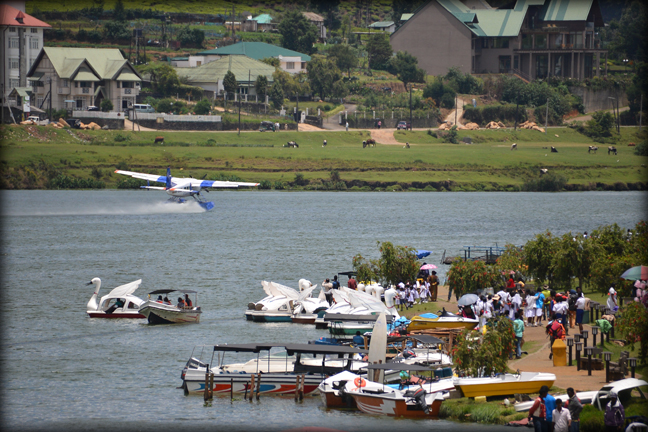 Nuwara Eliya has been in high gear for the past several weeks,
preparing for the month long Spring Festival. Reporters Kishani
Samaraweera and Maneshka Borham and photographer Thilak Perara meet the
residents and explore the sights and sounds that are unique to Nuwara
Eliya when this piece of little England is in full bloom and ready to
party Nuwara Eliya has been in high gear for the past several weeks,
preparing for the month long Spring Festival. Reporters Kishani
Samaraweera and Maneshka Borham and photographer Thilak Perara meet the
residents and explore the sights and sounds that are unique to Nuwara
Eliya when this piece of little England is in full bloom and ready to
party
Vying for the Best Bloom
Among the many anticipated events in the town known for its famous
English style gardens, is the ‘April Bloom Best Garden Competition’, a
colourful annual contest with a trophy coveted by the most famous and
well kept gardens in the city. The competition is organised by the
Municipal Council of Nuwara Eliya with the aim of encouraging the flower
growers in the area.
 In
April when the flowers go into bloom English Roses, Dahlia, Barberton,
Gerberas, Lilies and Carnations are commonly seen in the lush gardens of
every home in this hill town. In
April when the flowers go into bloom English Roses, Dahlia, Barberton,
Gerberas, Lilies and Carnations are commonly seen in the lush gardens of
every home in this hill town.
Austin Wijethunge, coordinating officer and Officer in Charge of the
Victoria Park, who has been working for the Nuwara Eliya Municipal
Council for the past 30 years, say the garden competition started in
1938. “However, at first it was said to be a vegetable home garden
competition,” he says.
According to Wijethunge, the competition had been initiated as an
‘Agri Horticulture’ competition by the Wives of British planters during
the Colonial era. During that period, the residents of Nuwara Eliya had
had a home garden system where they grew their own vegetables, fruits
and also flowers for their own needs.
The completion had later been expanded to include both vegetables and
flowers for the Department of Agriculture, when later became the
organisers of the competing. “The vegetable show is not there anymore
but the flower show has continued to this day in a grand fashion” says
Wijethunge.
Elaborating on how the garden competition had evolved through times,
Wijethunge says the first venue was the present grand hotel premises,
with the local authority being in charge of the competition. “The first
flower show after the local authority took over, was held by the United
Club, a club formed by the planters, which was later was converted to
the Town Hall,” he says, explain that it was much later the venue was
changed to the Nuwara Eliya Park.
 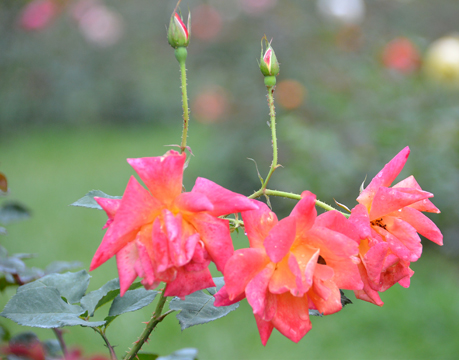 According
to Wijethunge, though the original competitors had been the wives of
British planters, locals had entered the scene after British left the
country. Today any party can participate with the Grand Hotel, Hillcot
Bungalow, Ceybank Rest, the Heritage Hotel being among the more famous
competitors. According
to Wijethunge, though the original competitors had been the wives of
British planters, locals had entered the scene after British left the
country. Today any party can participate with the Grand Hotel, Hillcot
Bungalow, Ceybank Rest, the Heritage Hotel being among the more famous
competitors.
Ceybank Rest, Nuwara Eliya, which has won the Best Garden competition
many times, is fully prepared to take part in the completion this year
as well.
According to its Manager R.B Thilakaratne, Ceybank Rest has taken
part in the competition for more than 20 years. “We prepare for the
flower show from November and the planting happens from mid December to
January. And then we maintain it till the competition commences,” he
explains.
An executive committee is appointed for the garden competition, which
is responsible for the judges and all the other events related to the
competition.
This year’s competition will include categories such as Best
Collection of Roses, Best Rose Garden, Best Commercial Garden, Cut
Flower Competition and many more.
Fruits in season ... And in history
The fruit market in Nuwara Eliya is vibrant and colourful but also
disappointingly banal. The shelves are artfully packed with imported
apples and pears, oranges and grapes all buffed and polished and looking
dewy fresh. The sight is nothing different to what you’d find in Colombo
or anywhere else.
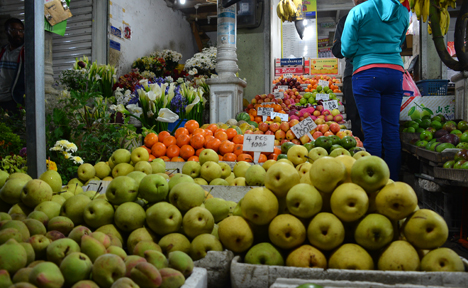 So
where are the fruits Nuwara Eliya was once known for? Fruits like local
apples and peaches and pears, even the sour guavas? Looking for them in
the busy market place is a laborious task, but look hard enough and you
do find them, but not in the quantity or even the quality you would have
envisaged. So
where are the fruits Nuwara Eliya was once known for? Fruits like local
apples and peaches and pears, even the sour guavas? Looking for them in
the busy market place is a laborious task, but look hard enough and you
do find them, but not in the quantity or even the quality you would have
envisaged.
Darshan Kumara of D.B Samson Silva stores, a store that solely sells
fruits admits that most of the fruits they sell are imported, even
though there is a high demand for locally grown fruits like pears and
apples. While once apples grown in Ragala were available for sale, he
says they never make it to the market anymore, as people do not grow
them, as it is cheaper to import them other countries such as Pakistan
and China.
As for local pears, he says the local variety will be available in
the market in mid-April and claims there isn’t a big market for the
imported variety among locals or visitors.
In the many fruit stalls in the market, there are strawberries,
peaches, pears and guavas for those looking for locally grown fruits.
Mohammed Shaffir who runs Shafir Fresh Food says that loquats, hill
country grapes, sweet passion fruit and ‘seeni anoda’ are also among the
very few fruits that they sell which are locally grown.
Shaffir also points out that apples which are grown in Nuwara Eliya
is much tastier than the imported ones, but that people have given up
growing apples due to several reasons.
“As only a very little quantity is produced, there isn’t enough
quantity to be sold in the market. There was a good demand for locally
grown apples however,” he admits.
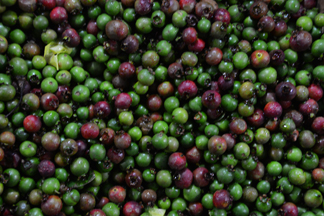 Senior
Professor of Horticulture, Faculty of Agriculture and Plantation
Management, Sumithra Jayasekara says fruit farmer have been mainly
growing pears throughout the years in the hill country. Senior
Professor of Horticulture, Faculty of Agriculture and Plantation
Management, Sumithra Jayasekara says fruit farmer have been mainly
growing pears throughout the years in the hill country.
“That was one of our major fruit crops cultivated in the up country
areas like Nuwara Eliya and Welimada,” he says, adding that farmers also
cultivated certain types of oranges, apples and a local type of peaches.
Pointing out that these fruits are not being cultivated in the way they
were cultivated before, he attributes the main reason to crop
replacement, with potatoes proving to be more profitable in the 1950s
Local apples that are hardly seen now were big sized fruits, slightly
sour and sweet when ripe, he reminisces, explaining, “After the British
rule a lot of food crops were introduced to us and they became quite
popular among the people in a very short period of time to the detriment
of other crops that were being cultivated.”
Explaining the history of the many vanishing fruits of the region, he
says farmers started cultivating potatoes in the Nuwara Eliya District,
expanding to Badulla later on. He says as there were no land, especially
to grow potatoes, the farmers not wanting to give up their vegetables
plots converted lands in which they grew pears into potato fields.
“It was economically more profitable for the farmers to grow potatoes
and there was no problem with the market. Also it was easy to
cultivate,” he clarifies, adding that unlike potatoes, it was difficult
to store pears for a long period, resulting in rather high post harvest
losses. This had led to the farmers gradually giving up cultivating
pears and other fruits that once used to be a common site in the region.
Professor Jayasekara says the Department of Agriculture had been
introducing a variety of peaches from Japan to the farmers in the last
25 years, but claims farmers are reluctant to let go of cultivating
potatoes because of the good income they get from the spuds.
With locally grown up country fruits are becoming rare, perhaps a
visit to the fruit market in Nuwara Eliya is a must these season to
sample these fruits that may not be available in years to come.
Vantage viewing
It is a place often overlooked in the list of places to visit when in
Nuwara Eliya. Lost amidst the more famous tea gardens, parks, English
style cottages, tea centres and markets, it however stands tall and
proud, offering a panoramic view of Nuwara Eliya that none could
compare.
Identified as Shanthipura, this seemingly unobtrusive site is perhaps
the best place to take in all that Nuwara Eliya has to offer.
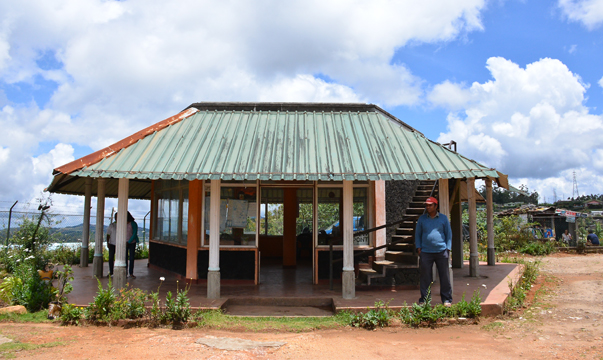 A
short drive out of Nuwara Eliya on the Kandy Road, and a turn off near
the Bambarakelle temple along the narrow Oliphant Estate Road takes
visitors right up the mountains to Shanthipura, a village situated in
the Kikiliyamana range of mountains. The village established by T.
William Fernando, a former Member of Parliament representing Nuwara
Eliya in the 1960s, is said located at the highest elevation in Sri
Lanka lying at 1,868 metres above sea level. In 1980 R. Premadasa, the
then Prime Minister provided better infrastructure facilities and
renamed the locality Mudungala, today it is still better known as
Shanthipura to the locals and visitors alike. A
short drive out of Nuwara Eliya on the Kandy Road, and a turn off near
the Bambarakelle temple along the narrow Oliphant Estate Road takes
visitors right up the mountains to Shanthipura, a village situated in
the Kikiliyamana range of mountains. The village established by T.
William Fernando, a former Member of Parliament representing Nuwara
Eliya in the 1960s, is said located at the highest elevation in Sri
Lanka lying at 1,868 metres above sea level. In 1980 R. Premadasa, the
then Prime Minister provided better infrastructure facilities and
renamed the locality Mudungala, today it is still better known as
Shanthipura to the locals and visitors alike.
A concrete road left off Oliphant Estate Road brings you to the
viewing point in Kalapura, Shanthipura. A small building with a circular
viewing deck at the top, it offers local visitors a bird’s eye view the
surrounding area for mere price of Rs 20 per local and Rs 50 per
foreigner. According to Ruwan Kumara, caretaker of the building, the
site was opened in 1975 by former Prime Minister Sirimavo Bandaranaike.
The air in Shanthipura even on a bright and sunny day feels much
cooler than in the busy Nuwara Eliya town. The viewing deck, a short
flight of stairs away, gives visitors a hawk’s eye view of the
surrounding areas including of the Nuwara Eliya town below.
On the right lies the Piduruthalagala Mountain range while in the
horizon one can even catch a glimpse of the Hakgala Mountain. On a clear
day, Ruwan Kumara says, visitors can see Adam’s Peak as well as the
Namunukula Mountain range. He is also eager to point out the Moon plains
along with several other interesting sites that can be viewed from the
deck.
Spread below the viewing point is the Nuwara Eliya town in all its
splendour. With a clear view from the top, guests can make out the boats
being rowed on the shimmering Gregory Lake and the vehicles streaming
through the Nuwara Eliya town, and of course its many cluttered
buildings. Hard to ignore in the view of a tea factory, the village’s
many vegetable gardens and lush tea estates. Pointing to a little lone
green house on top of a hill, Kumara says it is the house that is
located in the highest altitude in Sri Lanka. Glistening in the same
direction, a bit far off from the viewing point, Kumar points to the
Chethigiri Viharaya, the village temple. “It is the highest temple in
Sri Lanka,” he says.
Next to the viewing point is a small shop run by a local woman where
visitors can warm themselves up with a hot cup of coffee or tea.
According to Kumara around 2000 visitors arrive at Shanthipura annually,
though a majority of the visitors to Nuwara Eliya do not know of its
existence. With the drive to Shanthipura being hassle free it is surely
worth a visit here for its amazing panoramic view of Nuwara Eliya and
its surrounding areas.
The Grand icon
An icon that is pretty much a Nuwara Eliya identity is the historical
Grand Hotel, the most luxurious and the most sought after accommodation
option during the season and at all other times. A Landmark of the
Nuwara Eliya town, the Colonial building and its well manicured English
style lawns takes visitors to a bygone era of when Sri Lanka was Ceylon
and Nuwara Eliya did truly look like little England.
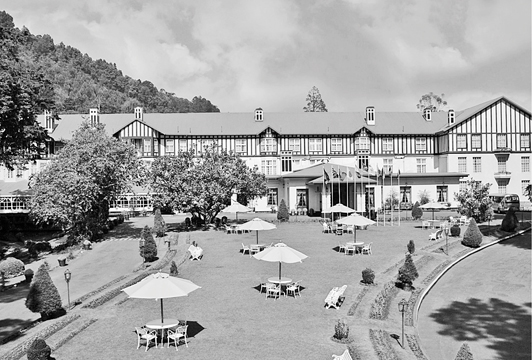 Built
in the style of an Elizabethan era manor house in 1828, the Grand Hotel
was once the palatial residence and holiday home of Sir Edward Barnes,
the fifth Governor of Ceylon. Barnes after being appointed Governor had
built the single storey bungalow at a cost of 8000 pounds, eventually
naming it ‘Barnes Hall’. Built
in the style of an Elizabethan era manor house in 1828, the Grand Hotel
was once the palatial residence and holiday home of Sir Edward Barnes,
the fifth Governor of Ceylon. Barnes after being appointed Governor had
built the single storey bungalow at a cost of 8000 pounds, eventually
naming it ‘Barnes Hall’.
However, following the departure of the Governor in 1831, the
bungalow was rented out to his successor, Sir Robert Wilmot – Horton,
and was later purchased by Reginald Beauchamp Downhill, a well known
planter and member of the Legislative Council of Ceylon. In 1892, it was
sold to Nuwara Eliya Hotels (Pvt) Ltd. for Rs 35 000. Today, the Grand
Hotel is run by the Tangerine Group.
The present day Hotel, modernised to meet the modern man’s
requirements, boasts of 154 rooms including six suites. A guide to
Nuwara Eliya, which was published in 1893 by Capper & Sons, states that
the price of a single bed at the Grand Hotel cost Rs 2.50 and Rs 4.00
for double room. The Guide also states a hot bath cost a guest 75 cents
extra, while a cold bath could set one back by a mere 50 cents. Coach
service to the Hotel and back from the railway station at Nanu Oya cost
Rs 3 per guest.
Expansion to the Hotel commenced in the 20th century, with the
Northern wings being the first additions, which was linked through an
archway to the main building. An extension was opened in 1904 and old
photos show the second floor added to the Northern wings linked by
corridor to the main building. A. Loesch, a former Hotel Manager from
Hamburg was appointed as the Manager of the Hotel in 1904, which period
also saw the Hotel expanding, with plans for 60 double and 40 single
rooms.
Given the landmark status it occupies, the Grand Hotel has had rich
and famous guests, including members of royal families, prominent among
them Lord Mountbatten, the Maharaja of Kapurthala Jagjit Singh, Sir
Thomas Lipton, Leopold of Saxe-Coburg-Gotha and the Grand Duke of Saxe-Weimar,
and Prince Reuss XXXII.
 Guest
Relations Officer Shaam Weerasuriya says the hotel is still a favourite
of many of travellers to the hill country. “Our hotel is popular,
particularly among British and Arab visitors,” he says, adding that over
10,000 guests from Arab countries have visited the Hotel. “They always
become returning clients,” he adds. Guest
Relations Officer Shaam Weerasuriya says the hotel is still a favourite
of many of travellers to the hill country. “Our hotel is popular,
particularly among British and Arab visitors,” he says, adding that over
10,000 guests from Arab countries have visited the Hotel. “They always
become returning clients,” he adds.
Weerasuriya says the hotel still maintains its original sections,
which were built over 200 years ago. “Due to good maintenance, these
sections still look the same as they once did” he says, adding that
Grand Hotel owns 17 acres of land including their own farms.
The Hotel named as a ‘National Heritage Site’ by the Department of
Archaeology in 1990, is not only of vast historical interest today but
also offers a wide variety of outdoor activities such as bird watching,
trekking, air rifle shooting, cycling, fishing, tea tours for it’s more
adventurous and outdoor loving guests.
According to Weerasuriya, the Hotel has programs to develop the
community and also to provide employment opportunities for the people in
the area. In a very sentimental gesture he says any guest visiting the
Hotel can plant a magnolia tree in the premises as remembrance of their
wonderful visit to The Grand Hotel.
The good, the bad and the Ugh!
What is the season actually like for its various residents?
Anusha Gayan runs Hotel Anuhas located opposite the Police station in
Nuwara Eliya. A small but very popular eatery, it has been in existence
for the past four years and has been doing pretty well. Gayan is excited
about the Spring Festival and is actually looking forward to it.
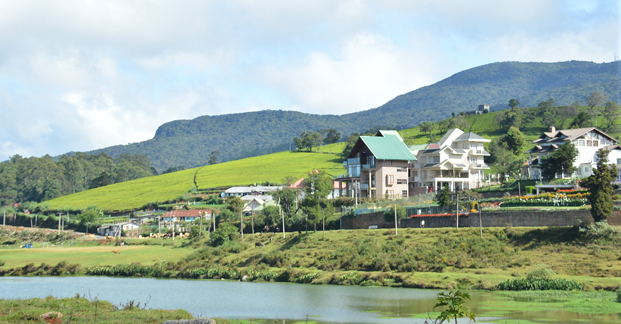 “Our
business goes up three times as much as on a normal day,” he says,
explaining that in previous years the full month of April used to be
considered as the season, but now they only see a surge in the crowds
during the first two weeks of the month. However, he says the end of the
season does not mean business is bad for them. “Our
business goes up three times as much as on a normal day,” he says,
explaining that in previous years the full month of April used to be
considered as the season, but now they only see a surge in the crowds
during the first two weeks of the month. However, he says the end of the
season does not mean business is bad for them.
His regular clientele and returning customers consist mainly of bank
and government employees and the Police. They bring him good business
keeping him busy throughout the year.
Contrary to Gayan, Upul, a 44-year-old resident of Nuwara Eliya, who
has been selling hats, jerseys and other cool weather items in the
vicinity of Lake Gregory for the past 20 years, says the Spring Festival
does not mark a large improvement in business. “Business is slow and I
have not made even Rs. 100 today,” he says.
He however admits that in preparation for the season he generally
brings around 100 items whereas before and after April he only brought
around 50 items for sale. But even so, he says business is tough, even
during April and that he is compelled to approach crowds in buses and
other public places to sell his wares in order to make a living. “I
struggle to make a living. This is my livelihood and I do this business
throughout the year” he says.
While many vendors and business people look forward to the Spring
Festival, D.R.P.D Rajapaksha, 26-year-old trishaw driver is perhaps one
person who least looks forward to it. “I personally do not like the
April season as it causes a lot of chaos and traffic in the city” he
says, adding that this is bad for his business. “We waste a lot of fuel
on the road to get to even small distances,” he says pointing out that
crowds do not mean more business as they all visit the town in their own
vehicles, so business for them sees no improvement during the time.
In fact he finds the season hampers his livelihood. “I personally
prefer the off season and wish people did not come here in such large
numbers” he says, perhaps waiting for the season to be over so his life
and business can get back to normal.
Pony Handler Kumar too is not too enthusiastic about the Spring
Festival. “For us there is no difference between the month of April and
the other months of the year,” he says, explaining that business is slow
throughout the year though they remain near the turf club seeking
visitors.
“People come for rides mostly on holidays,” he says claiming that
business does pick up after April 15, but not significantly.
Kumar believes the Spring Festival this is year is drawing a larger
crowd because of the opening of the Royal Turf Club, but he is reluctant
to say if this has made a change in the business. Kumar says even though
it is difficult to get by with the earnings he makes, he won’t change
anything because this has been his livelihood for many years.
Praneetha, a school teacher and housewife bemoans the fact that
prices of everything go up during the Spring Festival. “But that is
mostly in hotels. In smaller shops items are generally the same,” she
clarifies, adding that most of Nuwara Eliya including its residents look
forward to the Spring Festival. “We grow flower plants for sale solely
aiming for the month of April,” she says, even though she is not in the
business of selling plants. “It’s a good time for us,” she admits |

